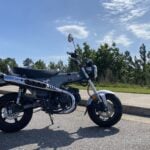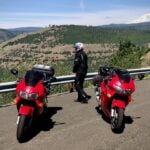The motorcycle sidecar manufacturer celebrates 80 years of rugged machines
Back a couple of years ago, my friend Kevin Morgan rolled up to a local bike night on a desert camouflage 2010 Ural motorcycle and sidecar rig. The bike looked so amazing and WWII era, I jokingly asked, “Where’s the machine gun mount?” I was intrigued as to why Kevin purchased a Ural, as I’d always known him to be a sport bike and sport tourer guy. He told me, “I just wanted to ride a piece of history, of military heritage, and had the chance to buy this, so I jumped on it. Literally. It’s also just so much fun to ride. Everybody wants a spin in it!” Can’t say that I blame them, nor Kevin for buying it. There really is a very vintage look and vibe to the Ural, a nostalgic draw the machine elicits.
So when I recently discovered Ural Motorcycles was celebrating 80 years of continuous production this year, I decided to dig a little into their history. Borne of war, during the bloodiest conflict of the 20th century, and designed for the harsh conditions of the European and Russian battlefields, the Ural has stood the test of combat and time, outliving every other piece of military machinery of that era.
Kevin’s 2010 Ural Gear-Up, with son Malachi along for a ride.
The Soviet Union had signed a non-aggression treaty with Nazi Germany in 1939, the Molotov-Ribbentrop Pact, but Soviet premier Joseph Stalin suspected Hitler might turn on him at some point. By 1940, the Soviets began preparing for a possible invasion across their European borders after witnessing the swift “Blitzkrieg” invasion of Poland by the German armored and infantry divisions, as well as the German Luftwaffe air assaults. The Soviets were plagued with outdated and inefficient military equipment, a deficiency they painfully realized after their costly winter war with Finland. They needed to modernize, and fast.
The Soviet Defense Ministry set about rapid modernization of their weapons, manufacturing capabilities and quality. And they needed a tough, durable, go-everywhere, do-everything motorcycle for the Red Army. The pact with Germany had landed the Soviets a small fleet of German BMW R71 sidecar bikes, and the high command felt it was ideally suited to the harsh climates and tough terrain the Red Army would be fighting in to defend their homelands. Engineers dismantled and reverse engineered the efficient and durable BMW airhead design, making molds and dies to produce their own versions in the Moscow Motorcycle Plant. They dubbed their machine the Dnepr M-72, and with Stalin’s approval launched into mass production in 1941 at Moscow, Leningrad and Kharkov plants.
The 1941 Dnepr M-72
The Nazi Blitzkrieg did come, with devastating ferocity and swiftness, sending Red Army forces reeling in the opening weeks and months of what became known as the Eastern Front of the war. Soviet command feared the Moscow plant would soon be within range of German bombers, so the decision was made to move the motorcycle plant, as well as other mass production facilities, further east, deep into the Ural Mountain region. For the motorcycle plant, the town of Irbit was chosen for its access to resources and trade/transportation routes. A brewery outside of town was selected, with R&D then production kicking into high gear for the war effort. By October 25, 1942, the relocated production facilities started cranking out the now-proven IMZ M-72, eventually producing nearly 9800 for the Red Army of the tough bike and sidecar.
Production continued after the war, primarily for the Soviet military. The KMZ plant in Ukraine, previously at Kharkov, continued to produce machines for the military, but the IMZ (Irbit Motorcycle Works) plant in Irbit switched production to domestic bikes by the late 1950s. Both tough and easy to work on, the war-era machine was popular with Russian citizens as well as a growing market abroad. The M-72 production lines were eventually sold to China in 1957 as the company produced subsequent improved models and expanded their lineup to meet growing national and worldwide demand.
A few of Ural’s modern offerings: The Sportsman, Sahara, Geo and Weekender. Photos by Ural Motorcycles.
Ural’s modern machines are built with their patented two-wheel-drive, four-speed Herzog gearbox tranny with reverse, they run four-stroke, EFI, air-cooled 749cc flat twins, push power to the rear wheel wheel via a sealed shaft drive, two-disc dry clutch, and Brembo brakes all around. Ural employs a Nippon Denso camshaft gear-driven alternator now, as well as a Ducati electronic ignition. The sidecars all have a lockable, watertight trunk and spare tire. This bike is truly an all-rounder, from urban to backwoods. “On The Road Since Before It Was Paved” is their motto, and its been well-earned these 80 years.
For more on Ural, the various models and offerings for their unique rigs, check them out on the web, find a dealer near you, and see about getting a test ride on one yourself-
Rob
Ah, those crazy Cossacks. Photo by Ural Motorcycles.
































I have a 1994 Ural 650, bought it as a non runner. Spent a year rebuilding it, love it.
Been riding it now for ten years with no major problems.
Very cool, Alan! Glad you’ve still got the rig, and enjoying it.
Alan – The Dnepr M-72 was so-named as the factory was alongside the Dnepr River in what is now the Ukraine. Fearing the Nazi invasion they built another factory in the Ural Mountains, well to the east. In the 1980s Dneprs were imported to the US, called the Neval MT as they were massaged by the Neval Motorcycles company in England in order to meet American specs. I did a road test on one in the January 1983 Road Rider magazine. Clement Salvadori
Thank you for your additional insights and information, Clement. I hope you enjoyed our abbreviated treatise on the Ural.
Rob